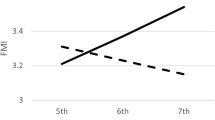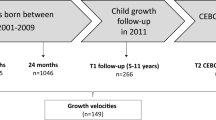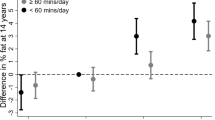Abstract
OBJECTIVES:
Our previous cross-sectional analysis of MIT Growth and Development (MIT) Study girls showed that activity temperament, as assessed by a nine-item temperament questionnaire, was related to body composition and nonresting energy expenditure (NREE). In girls with lower levels of physical activity, having a high activity temperament was associated with a higher NREE. Percentage body fat was lower in girls with high vs low activity temperament. Based on these results, we hypothesized that, especially in girls with declining levels of physical activity over adolescence, high activity temperament in childhood would be protective against increased adiposity during adolescence. We tested this hypothesis with longitudinal data from the MIT study.
DESIGN, SETTING, AND PARTICIPANTS:
A total of 196 nonobese premenarcheal girls 8–12 y old were enrolled between 1990 and 1993. Girls were followed until 4 y postmenarche; average duration of follow-up was 7 y.
MEASURES:
Activity temperament was assessed at baseline by the girls' mothers with questions modified from those developed by Thomas and Chess that tapped predilection for movement. Temperament, the stylistic component of behavior, is considered relatively stable within an individual. Body composition was assessed by total body water at baseline and study completion (4 y postmenarche), and by bioelectrical impedance (BIA) annually. Physical activity was assessed annually by questionnaire, and by activity diary at baseline only.
RESULTS:
Child activity temperament was not associated with percentage body fat at 4 y postmenarche in multivariate regression models controlling for baseline percentage body fat, physical activity, parental obesity status, age at menarche, age at baseline, and race-ethnicity. Body composition of girls with low and high activity temperaments who reported declining levels of physical activity over adolescence was not statistically significantly different at study completion. In longitudinal models of percentage body fat by BIA, high activity temperament was not associated with lower adiposity.
CONCLUSION:
Although high activity temperament was associated cross-sectionally with lower percentage body fat and higher NREE, we did not find evidence to support our hypothesis that high child activity temperament would be protective for increased adiposity prospectively in our cohort of girls followed over the adolescent period.
This is a preview of subscription content, access via your institution
Access options
Subscribe to this journal
Receive 12 print issues and online access
$259.00 per year
only $21.58 per issue
Buy this article
- Purchase on Springer Link
- Instant access to full article PDF
Prices may be subject to local taxes which are calculated during checkout

Similar content being viewed by others
References
Levine JA, Eberhardt NL, Jensen MD . Role of nonexercise activity thermogenesis in resistance to fat gain in humans. Science 1999; 283: 212–214.
Levine JA, Schleusner SJ, Jensen MD . Energy expenditure of nonexercise activity. Am J Clin Nutr 2000; 72: 1451–1454.
Anderson SE, Bandini LG, Dietz WH, Must A . Relationship between temperament, nonresting energy expenditure, body composition, and physical activity in girls. Int J Obes Relat Metab Disord 2004; 28: 300–306.
Bandini LG, Must A, Spadano JL, Dietz WH . Relation of body composition, parental overweight, pubertal stage, and ethnicity to energy expenditure among premenarcheal girls. Am J Clin Nutr 2002; 76: 1040–1047.
Must A, Dallal GE, Dietz WH . Reference data for obesity: 85th and 95th percentiles of body mass index (wt/ht2) and triceps skinfold thickness. Am J Clin Nutr 1991; 53: 839–846.
Ogden CL, Kuczmarski RJ, Flegal KM, Mei Z, Guo S, Wei R, Grummer-Strawn LM, Curtin LR, Roche AF, Johnson CL . Centers for Disease Control and Prevention 2000 growth charts for the United States: improvements to the 1977 National Center for Health Statistics version. Pediatrics 2002; 109: 45–60.
Halliday D, Miller AG . Precise measurement of total body water using trace quantities of deuterium oxide. Biomed Mass Spectrom 1977; 4: 82–87.
Schoeller DA, van Santen DW, Peterson DW, Dietz W, Jaspan J, Klein PD . Total body water measurement in humans with 18O and 2H labeled water. Am J Clin Nutr 1980; 33: 2686–2693.
Phillips SM, Bandini LG, Compton DV, Naumova EN, Must A . A longitudinal comparison of body composition by total body water and bioelectrical impedance in adolescent girls. J Nutr 2003; 133: 1419–1425.
Ching PLYH, Dietz WH . Reliability and validity of activity measures in preadolescent girls. Pediatr Exer Sci 1995; 7: 389–399.
Ainsworth BE, Haskell WL, Leon AS, Jacobs DRJ, Montoye HJ, Sallis JF, Paffenbarger RSJ . Compendium of physical activities: classification of energy costs of human physical activities. Med Sci Sports Exer 1993; 25: 71–80.
Thomas A, Chess S . Temperament and development. Brunner/Mazel Publishers: New York; 1977.
Goldsmith HH, Buss AH, Plomin R, Rothbart MK, Thomas A, Chess S, Hinde RA, McCall RB . Roundtable: what is temperament? Four approaches. Child Dev 1987; 58: 505–529.
Lerner JV, Lerner RM . Temperament and adaptation across life: theoretical and empirical issues. In: Baltes PB, Brim OG (eds). Life-span development and behavior. Academic Press: New York; 1983. p 197–231.
Hubert NC, Wachs TD, Peters-Martin P, Gandour MJ . The study of early temperament: measurement and conceptual issues. Child Dev 1982; 53: 571–600.
Mufson L, Fendrich M, Warner V . The stability of temperament by child and mother reports over two years. J Am Acad Child Adolesc Psychiatry 1990; 29: 386–391.
Pesonen A-K, Raikkonen K, Keskivaara P, Keltikangas-Jarvinen L . Difficult temperament in childhood and adulthood: continuity from maternal perceptions to self-ratings over 17 years. Pers Indiv Differ 2003; 34: 19–31.
Acknowledgements
We gratefully acknowledge Elena Naumova for her thoughtful comments on our statistical approach, Jennifer Spadano, and the staff at the Clinical Research Center for their assistance with the study, as well as the girls who enrolled for their participation and commitment. This study was also supported by NIH Grants DK-50537, M01-RR-00088, 5P30 DK46200 and T32-DK62032-11.
Author information
Authors and Affiliations
Corresponding author
Rights and permissions
About this article
Cite this article
Anderson, S., Bandini, L. & Must, A. Child temperament does not predict adolescent body composition in girls. Int J Obes 29, 47–53 (2005). https://doi.org/10.1038/sj.ijo.0802844
Received:
Revised:
Accepted:
Published:
Issue Date:
DOI: https://doi.org/10.1038/sj.ijo.0802844
Keywords
This article is cited by
-
A new model for estimating basal metabolic rate (BMR) using temperament in traditional Persian medicine (TPM)
Advances in Traditional Medicine (2023)
-
Does Childhood Temperamental Activity Predict Physical Activity and Sedentary Behavior over a 30-Year Period? Evidence from the Young Finns Study
International Journal of Behavioral Medicine (2017)
-
Infant temperament and eating style predict change in standardized weight status and obesity risk at 6 years of age
International Journal of Obesity (2010)
-
Physical activity and sedentary behavior: a review of longitudinal studies of weight and adiposity in youth
International Journal of Obesity (2005)



